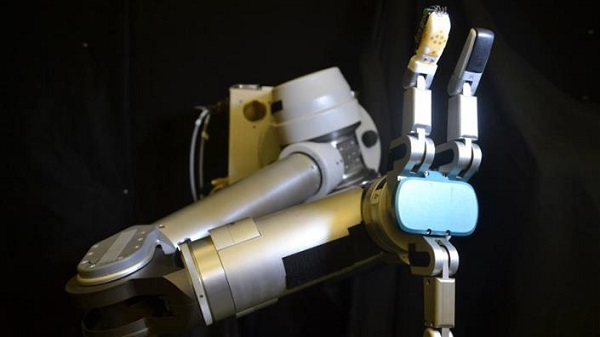Engineers have developed a ‘skin’ for robots and prosthetics that could massively boost their dexterity when handling objects.
Bio-inspired, the flexible sensor ‘skin’ developed at the University of Washington (UW) can be stretched over any part of a prosthetic or robot’s body, giving them the ability to accurately sense shear forces and vibrations providing essential feedback, such as when an object is slipping out of their grasp.
With robots traditionally caricatured as being clumsy, the technology could help them to perform commonplace tasks like grasping and manipulating everyday objects with human-like precision. It could also eventually make prosthetics much more useful for humans.
“Robotic and prosthetic hands are really based on visual cues right now – such as, ‘Can I see my hand wrapped around this object?’ or ‘Is it touching this wire?’” said the university’s professor of mechanical engineering Jonathan Posner, senior author of the study published in Sensors and Actuators A: Physical. “But that’s obviously incomplete information.”
The robotic sensor ‘skin’ mimics the feedback humans feel from the sense of touch on their skin – the secret behind very precise movements. The development could revolutionise robotics, according to the team – with precise haptic feedback having the potential to vastly improve the ability of robots to perform everything from cleaning a kitchen to surgical and industrial procedures.
Too early?
“If a robot is going to dismantle an improvised explosive device, it needs to know whether its hand is sliding along a wire or pulling on it. To hold on to a medical instrument, it needs to know if the object is slipping. This all requires the ability to sense shear force, which no other sensor skin has been able to do well,” Posner added.
However, Helge Wurdemann, a specialist in medical devices at University College London, told PE that, while the research was “very promising” since it combined “all the sensations” required to replicate human skin, such technologies continue to have major drawbacks for prosthetic use because they tend to be very heavy and costly.
Wurdemann’s own research aims to avoid both of these problems with 3D-printed parts that contain no electronics and instead are powered by the body, such as the movement of the wrist. He said that these types of prosthetics are likely to be a better option for low- and middle-income countries that cannot afford the electronic solution. Developed nations could opt for his approach as well, he added, for users who want lighter prosthetics or wish to avoid charging batteries.
While the robotic skin “will benefit in the future, it’s not the right time,” said Wurdemann, adding that users of prosthetics will have to wait for the electronic technology to become lighter and cheaper.
‘Better than a human finger’
Manufactured at UW’s Washington Nanofabrication Facility, the stretchable electronic skin is made from silicone rubber, the material used in swimming goggles.
Inside the rubber are built-in tiny serpentine channels – around half the width of a human hair – filled with electrically conductive liquid metal. Using liquid metal means the skin won’t fatigue or crack when stretched as would happen with solid wires.
When a human slides their finger across a surface, one side of the finger bulges out while the other becomes taught under tension. As the same happens with the rubber skin, the amount of electricity that can flow through the liquid metal in these channels changes as some channels get compressed and others stretched. These differences in electrical resistance can be used to interpret the shear forces and vibrations the robot or prosthetic is experiencing.
Tests by the team have shown that the chemically resistant and physically robust sensor skin performs well with good precision and sensitivity for light-touch applications – whether when opening a door, shaking hands or handling objects. They also show that the skin is even better than human fingers in some areas, being able to detect tiny vibrations at a rate of 800 times a second.
“By mimicking human physiology in a flexible electronic skin, we have achieved a level of sensitivity and precision that’s consistent with human hands, which is an important breakthrough,” said Posner.



















